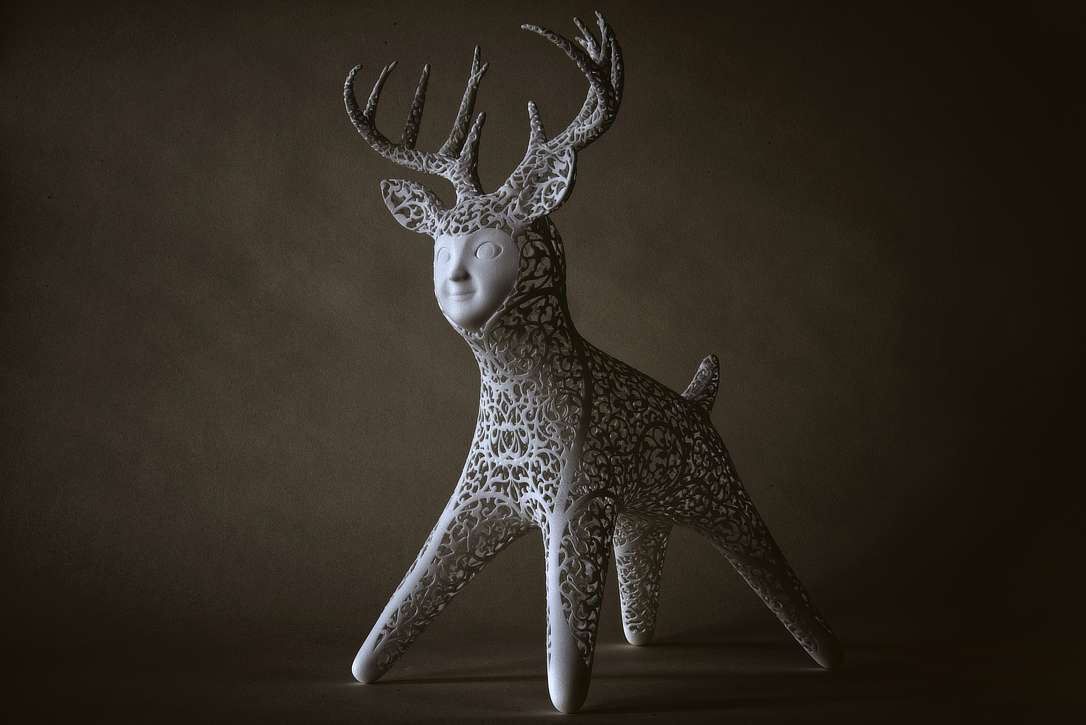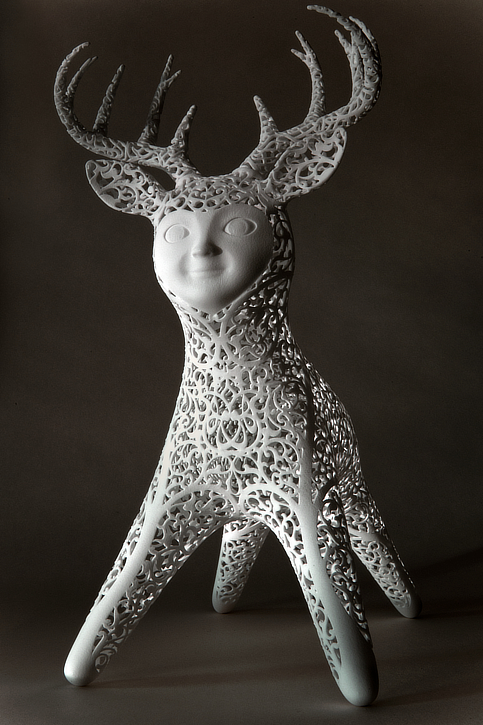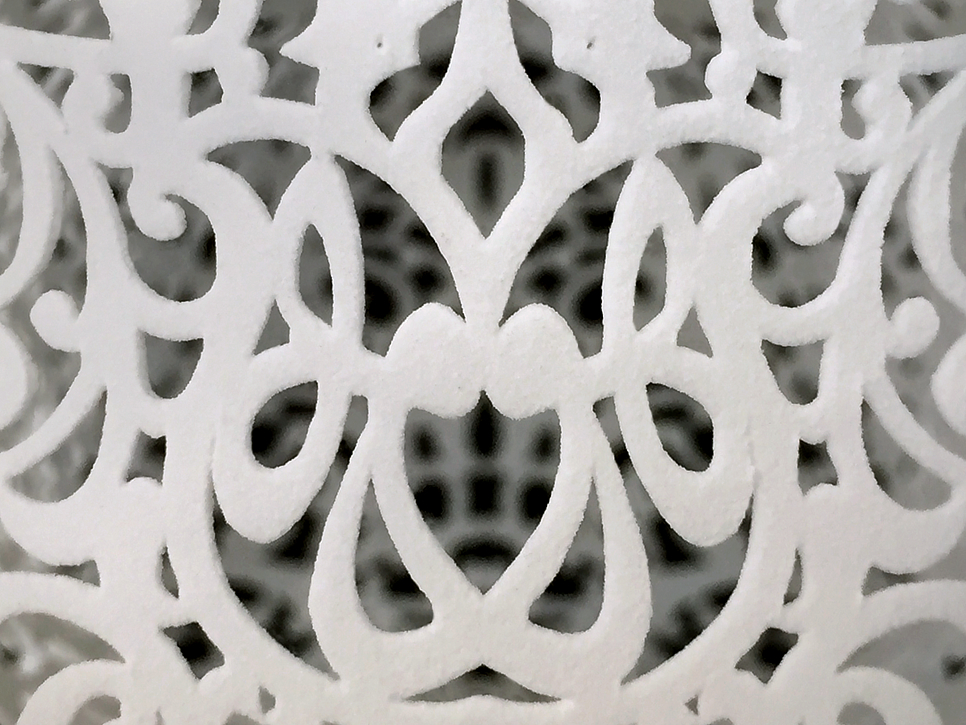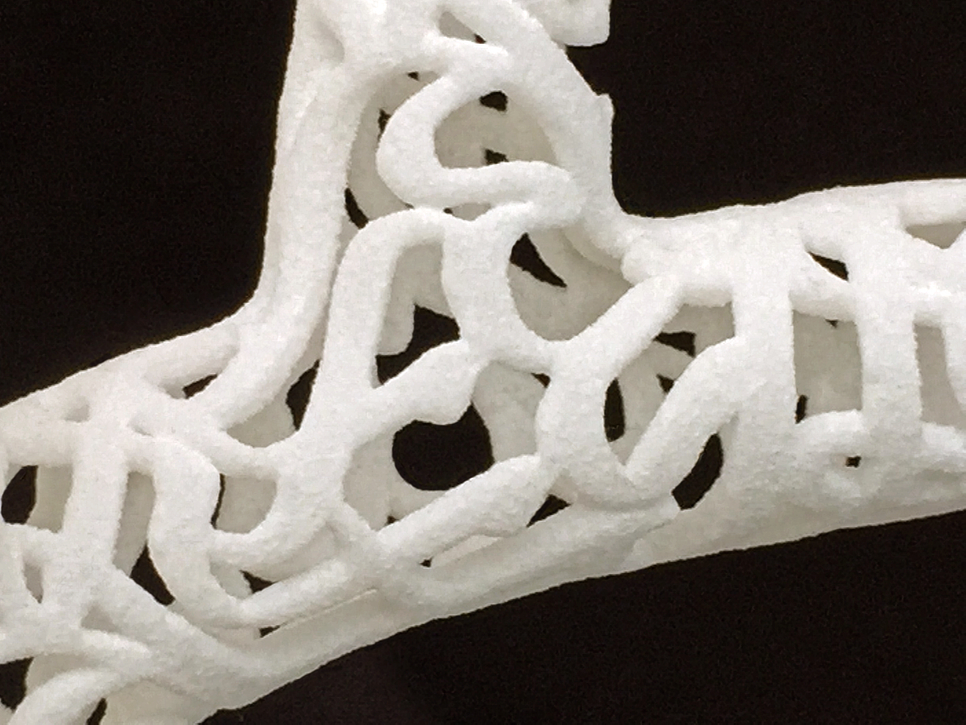Ah-who; 3D printed, 7″ x 10″
Now available at Shapeways
Ah-who is a limited edition 3-D printed sculpture that has been conceived to invoke the magical world of Persian myth and folklore. Created from an intricate, open work arabesque pattern, combined with stylized calligraphy, this piece also references traditional animal shaped incense burners. Ah-who, the Persian word for deer, has been inspired by classical Persian art, poetry and philosophy, and in particular their use of symbolic and metaphorical language.
What did your face look like before your parents were born?
Zen Koan
Ah-who represents a hybrid mythical being with the body of a deer and the face of a human, and measures approximately 12” tall, 10” long and 6” wide. The entire body, the ears and the antlers are rendered in filigree, while the face is solid. The sinuous pattern covering the body and ears is that of a highly stylized floral design commonly referred to as Islimi or Arabesque. The chest area displays a calligraphic icon representing the Arabic word meaning ‘that which is Real’. The design utilized for the antlers is another calligraphic icon that says ‘Reality is One-illusion many’. Ah-who utilizes a playful and symbolic approach to explore what it means to be a human,
Similar to other mythical creatures such as the Egyptian Sphinx, the Greek Centaur, the Chinese Qilin or the Indian Garuda, Ah-who brings together the symbolic strength of two different creatures and creates a hybrid form as a metaphor for the unity of existence. Like the imaginary and magical creatures of the past, Ah-who is empowered by allegorical language and other iconographic details to portray its story and meaning.
The story for this piece begins by creating a juxtaposition of a human face with the body of an animal, and continues by using this relationship, as an analogy to investigate what is/ could be a human being. For instance, if we are able at times, to act a lot worse than even the most savage beasts, and yet at other times, display a host of more refined qualities and characteristics, what definition could we then offer for a human?
Furthermore, if it is true, that we possess a vast range of possibilities, and that one can evolve from a lower state into more refined level of being, then what exactly is the full extent of these latent potentialities? What is this essence that lies dormant at the core of our being? What is it that truly constitutes a human being that exists above and beyond any momentary manifestations relative to a specific time or space? What is our Reality? What is our true and original face?
The title for this piece is a play on the Persian word for deer, Ah-hu. This word is composed of two syllables; “ah” and “hu”. “Ah” is also the first syllable in the word Ah-daam (Adam), which means human being, and “hu” is the same word that appears on the chest. “Hu/ who”, meaning “that which is Real”, focuses the viewer’s attention on a state of being that is stable, constant and never changing in or by time. The placement of this calligraphic icon on the deer’s chest at the visual center of the piece, suggests that perhaps this stable, unchanging reality is at the very heart of the matter. For instance, in observing a seed that somehow contains within it the entire life cycle of a plant, is it not possible too, for “that which is real” to be the very source and seed, out of which the pattern/ natural world is manifested?
The filigree pattern that forms the body, ears and the antlers, is from the same family of designs that have been utilized throughout the history of Islamic art, architecture and craft. It is an all-over, winding, sinuous pattern that has no beginning or end, which in turn refers to the ever- changing forms, shapes and colors in nature/ physical reality.
Meanwhile, the sculptural details around the face not only help to emphasize the separation between it and the body, but also suggests that either the animal body is enveloping the human face, or that the face is emerging out of the body. The face, being made of a solid material, in comparison to the illusive presence of the body, tends to read as more real than the body. In other words, this dynamic between the face, which is real and the body, which is ever changing/ illusive, suggests that perhaps there is a further level of reality that is actually veiled by/within the physical world.
The antlers too, like a Tree of Life, echo the same concept as the pattern, in the sense that they divide into a multitude of smaller and smaller branches, thereby signifying the multiplicity, relativity and in essence the duality of the natural/ physical world. Meanwhile, the text on the antlers points toward the notion that there is only one reality out of which all forms, shapes, and colors come into being.
What was a deer before it was a deer, or a tree, before it was a tree? To once again consider a seed, it is logical to deduce that the tree exists (in some form) encoded or enfolded within the seed before it takes its physical form. If that is so, then the reality of the tree (or anything else for that matter) cannot, by definition, be limited to only that which is physical. What then, is the nature of this Reality? What is my Reality? What face did I have, before my parents were born?





